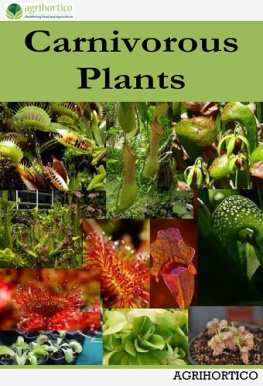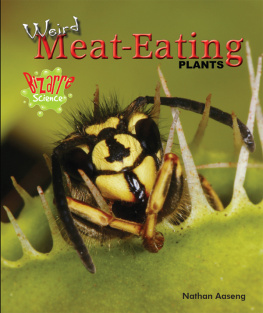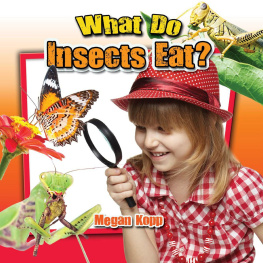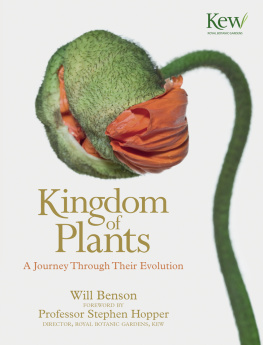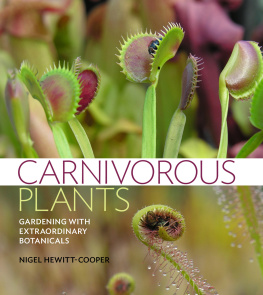Carnivorous Plants
AGRIHORTICO
Copyright 2019 AGRIHORTICO
All rights reserved.
www.agrihortico.com
table of contents
Autotrophic and Heterotrophic Plants
B roadly speaking, a plant is a multicellular photosynthetic eukaryotic life-form that grows in permanent site absorbing water and nutrients from its growing media through a well-developed root system for its growth and development. All plants are members of the Plant Kingdom (Kingdom Plantae). There are different types of plants: small and big, seed-bearing and non-seed bearing, flowering and non-flowering, aquatic and terrestrial, epiphytic and lithophytic, parasitic and saprophytic, and so on.
It is believed that there are millions of plant species in existence on this planet Earth. However, approximately 4 lakhs species of plants are known to science till date. Out of these plants, about 95% are vascular, flowering and seed-bearing plants, those plants that we see around us every day. Rest 5% comprises of plants that are rare and are less known to the world.
Classification of Plants: Plants may be grouped into different categories based on their uses, functional characteristics, economic importance etc. One major classification that is based on the nutritional aspects of the plants is autotrophic and heterotrophic.
Greek word auto means self, hetero means different and trophic means relating to nutrition. Autotrophic plants are those plants that are capable of self synthesising their own food by using light energy. Almost all green plants with chlorophyll pigments are considered as autotrophic plants.
Heterotrophic plants are different from autotrophs in the fact that they are unable to produce their own foods and depend on other plants for their food and nutrition. Examples of heterotrophic plants are parasitic plants and saprophytic plants.
Autotrophs are food producers while heterotrophs are consumers. There are some plants that exhibit both autotrophic and heterotrophic characteristics. For example: carnivorous or insectivorous plants.
Carnivorous plants are very interesting because of their habit of carnivory and it is worth the effort to study about these rare and wonderful carnivorous plants. This small booklet is intended to provide brief basic information about 11 groups of popular carnivorous plants.
Carnivorous Plants: An Introduction
C arnivorous plants are those plants that depend on insects and small animals for their nitrogen supply and proteins (inorganic nutrition). They derive some or most of their nutrients from trapping and digesting small animals and insects by means of specially modified plant organs or trapping mechanisms. Today, there are over 600 known species of carnivorous plants in the world and most of them are herbaceous perennials that live in nutrient-poor soils.
Carnivorous plants are commonly found in areas where soil is thin and poor, water is abundant, and nitrogen is deficient due to unfavourable atmosphere for nitrifying bacteria (for example, acidic boggy soils or marshes). These plants are capable of synthesizing carbohydrates and thus are able to meet their energy demands. However, for their inorganic nutrition, they have to depend on their habit of carnivory.
Carnivorous plants are also called insectivorous plants as most of the species feed on insects. Very few species are found feeding on small animals. Popular examples of carnivorous plants are tropical pitcher plants or Nepenthes, Venus fly trap, Darlingtonia, Drosera or Sundews, bladderworts and butterworts. These plants are partially autotrophic and partially heterotrophic. They possess green pigments for photosynthesis and can manufacture carbohydrates. However, they are not capable of synthesizing nitrogenous compounds and proteins. For their protein requirements, these plants trap insects, bugs and small animals, and feed on them by using specific feeding mechanisms or prey-trapping mechanisms developed in these plants.

Figure 1: A Carnivorous Plant with Pitchers and Flowers
Prey-Trapping Mechanism
P rey-trapping mechanism in a carnivorous plant is always a highly modified leaf. There are FIVE different types of trapping mechanisms that are found in carnivorous plants. A detailed account of these traps is as given below:
Pitfall Traps: It is the most common type of prey-trapping mechanism found in carnivorous plants. Pitfall trap is nothing but a modified leaf with a pitcher and a lid . Pitcher is filled with digestive juices containing various digestive enzymes. Prey that falls in this liquid gets digested by the plant. Pitfall trap is a passive type of trapping mechanism. Pitfall traps are found in carnivorous plants such as Darlingtonia, Heliamphora, Sarracenia, Nepenthes, and Cephalotus.
Flypaper Traps: Fly paper trap is nothing but a modified sticky leaf. These leaf traps secrete sticky mucilage to trap the prey. Sticky mucilage is secreted either directly on the surface of the leaves or through glandular hairs present on the leaves. Fly paper trap can be active or passive. Sundews have active fly paper traps where sticky mucilage is secreted through long and mobile glandular hairs and leaves become mobile to trap the prey.
Snap Traps: Snap trap is nothing but a modified leaf with sensitive hairs or trigger hairs which enable rapid movements of the leaf. It is an active trapping mechanism. When a leaf trap is stimulated by the touch of the prey, it suddenly closes entrapping the prey which is later digested by the plant. A leaf trap is responsive to stimulus only twice or thrice, and after that, it becomes unresponsive to stimulus. Snap traps are present in Venus fly trap and Aldrovanda.
Bladder Traps: A bladder trap is nothing but a leaf modified into a bladder-shaped trap . A vacuum is always maintained inside the bladder which has a small opening or mouth also. When the trigger hairs at the mouth of the bladder trap are stimulated by the contact of the prey, the mouth opens sucking the prey inside the bladder along with the water. Bladder trap is an active trapping mechanism and are found in bladderworts.
Lobster-Pot Traps: A lobster-pot trap is nothing but a highly modified underground leaf that is Y-shaped. It allows the prey to enter into the trap easily but difficult to escape. It is found in Genlisea, the corkscrew plants.
Major Carnivorous Plant Families
M ost of the carnivorous plants belong to the plant families such as Lentibulariaceae, Droseraceae, Sarraceniaceae, Nepenthaceae, Cephalotaceae, and Byblidaceae. A detailed account of these plant families is given below:
Lentibulariaceae : Plant family Lentibulariaceae is considered as the largest carnivorous plant family that are cosmopolitan in distribution. Lentibulariaceae family consists of over 350 known species of plants. Prominent members of Lentibulariaceae are Bladderworts and Butterworts.
Droseraceae : Plant family Droseraceae is also a large group of carnivorous plants with over 150 known species of plants belonging to this family. It includes popular carnivorous plants such as sundews or droceras, Aldrovanda, and Dionaea or Venus fly trap.
Sarraceniaceae : Plant family Sarraceniaceae is a small group of carnivorous plants that includes plants such as Sarracenias, Heliamphora and Darlingtonia.
Nepenthaceae : Plant family Nepenthaceae consists of 100-150 known species carnivorous plants, mainly tropical pitcher plants with varied growth habits. The largest carnivorous plant

